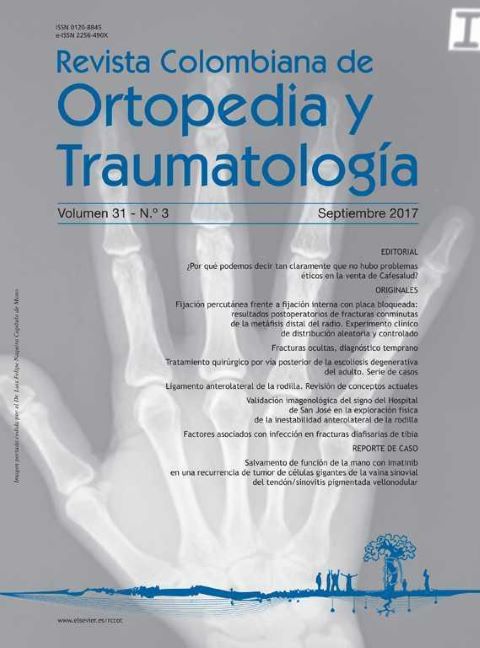Percutaneous pinning vs. internal fixation with locking plate: Postoperative results of comminuted fractures of the distal radius metaphysis. A randomised controlled trial
DOI:
https://doi.org/10.1016/j.rccot.2017.04.004Keywords:
radius, radius fractures, bone plates, surgical procedures, operative/complicationsAbstract
Background: There is controversy surrounding the treatment of distal metaphyseal fractures of the radius. This has increased even more with the advent of fixation with locking plates and its notable increasing preference by surgeons in recent years, although its benefits have not yet been demonstrated in extra-articular fractures. This has led us to conduct a study that would enable us to define the best treatment method for this group of fractures.
Materials and methods: A controlled clinical trial was conducted in order to compare two methods of fixation of distal, extra-articular, radius fracture in adults. One group consisted of patients treated with closed reduction and percutaneous fixation (group 0), and a second group treated with open reduction and internal fixation with locked plate via volar approach (group 1). Radiological assessment, including clinical monitoring, was performed at 6 weeks and up to 52 weeks.
Results: A total of ¿67? patients (group: 36; group 1: 31) were included. Follow-up at 6 and 12 weeks were acceptable, but there was a high number of patients that were lost to follow-up at 26 and 52 weeks. There were no differences between the two groups in terms of consolidation and reduction quality, but there were differences in the strength and mobility advantage for open reduction and internal fixation.
Discussion: The study failed to show similar radiological and clinical outcomes for the two groups in the short-term. There were no significant differences in complications. A significant difference was demonstrated statistically in cost advantage for closed reduction and percutaneous fixation. Loss to follow-up limits us to draw conclusions about the outcome in the medium and long term, and therefore no recommendations are offered.
Evidence level: II.
Downloads
References
Chung KC, Spilson SV. The frequency and epidemiology of hand and forearm fractures in the United States. J Hand Surg Am. 2001;26:908-15. https://doi.org/10.1053/jhsu.2001.26322
Karl JW, Olson PR, Rosenwasser MP. The epidemiology of upper extremity fractures in the United States, 2009. J Orthop Trauma. 2015;29:e242-4. https://doi.org/10.1097/BOT.0000000000000312
Lam F, Jaysekera N, Karmani S, Jupiter JB. What's new in the treatment of distal radius fractures? Curr Orthop. 2006;20:208-11. https://doi.org/10.1016/j.cuor.2006.02.008
Margaliot Z, Haase SC, Kotsis SV, Kim HM, Chung KC. A meta-analysis of outcomes of external fixation versus plate osteosynthesis for unstable distal radius fractures. J Hand Surg Am. 2005;30:1185-99. https://doi.org/10.1016/j.jhsa.2005.08.009
Koval K, Haidukewych GJ, Service B, Zirgibel BJ. Controversies in the management of distal radius fractures. J Am Acad Orthop Surg. 2014;22:566-75. https://doi.org/10.5435/JAAOS-22-09-566
Müller ME, Allgöwer M. Manual of internal fixation: Techniques recommended by the AO-ASIF Group, 3rd ed New York: Springer; 1995. p. 118-150.
Hudak PL, Amadio PC, Bombardier C. Development of an upper extremity outcome measure: The DASH (disabilities of the arm, shoulder, and head). Am J Ind Med. 1996;29:602-8. https://doi.org/ckq79x
Gartland JJ, Werley CW. Evaluation of healed Colles' fractures. J Bone Joint Surg Am. 1951;33-A::895-907. https://doi.org/10.2106/00004623-195133040-00009
Grewal R, MacDermid JC, King GJW, Faber KJ. Open reduction internal fixation versus percutaneous pinning with external fixation of distal radius fractures: A prospective, randomized clinical trial. J Hand Surg Am. 2011;36:1899-906. https://doi.org/10.1016/j.jhsa.2011.09.015
Bales JG, Stern PJ. Treatment strategies of distal radius fractures. Hand Clin. 2012;28:177-84. https://doi.org/10.1016/j.hcl.2012.02.003
Chia B, Catalano LW, Glickel SZ, Barron OA, Meier K. Percutaneous pinning of distal radius fractures: An anatomic study demonstrating the proximity of K-wires to structures at risk. J Hand Surg Am. 2009;34:1014-20. https://doi.org/10.1016/j.jhsa.2009.04.004
Gofton W, Liew A. Distal radius fractures: Nonoperative and percutaneous pinning treatment options. Hand Clin. 2010;26:43-53. https://doi.org/10.1016/j.hcl.2009.08.012
Knox J, Ambrose H, McCallister W, Trumble T. Percutaneous pins versus volar plates for unstable distal radius fractures: A biomechanic study using a cadaver model. J Hand Surg Am. 2007;32:813-7. https://doi.org/10.1016/j.jhsa.2007.03.015
Tang JB. Distal radius fracture: Diagnosis, treatment, and controversies. Clin Plast Surg. 2014;41:481-99. https://doi.org/10.1016/j.cps.2014.04.001
Herrera M, Chapman CB, Roh M, Strauch RJ, Rosenwasser MP. Treatment of unstable distal radius fractures with cancellous allograft and external fixation. J Hand Surg Am. 1999;24:1269-78. https://doi.org/10.1053/jhsu.1999.1269
Downloads
Published
How to Cite
Issue
Section
License
Copyright (c) 2024 Revista Colombiana de ortopedia y traumatología

This work is licensed under a Creative Commons Attribution 3.0 Unported License.




